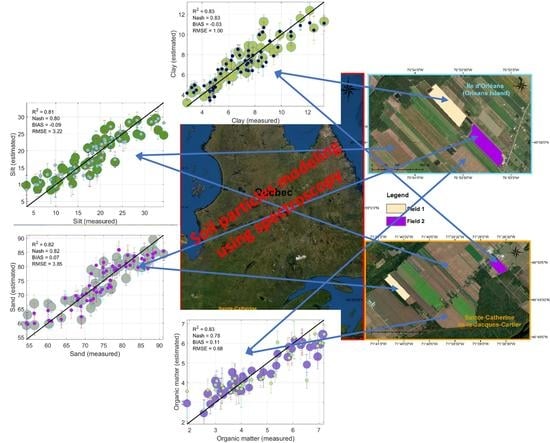Quantitative Study of the Effect of Water Content on Soil Texture Parameters and Organic Matter Using Proximal Visible—Near Infrared Spectroscopy
Abstract
:1. Introduction
2. Materials and Methods
2.1. Study Area
2.1.1. Soil Sample Preparation
2.1.2. Water Content Measurement
2.1.3. Reflectance Measurement
2.2. Statistical Methods and Evaluation Indices
2.2.1. K-Means Unsupervised Classification
2.2.2. Correlogram
2.2.3. Principal Component Analysis (PCA)
2.2.4. Classification and Regression Tree (CART)
2.2.5. Partial Least Squares Regression (PLSR)
2.2.6. Bootstrap k-Fold Cross-Validation (BKFCV)
2.2.7. Statistical Evaluation Indices
2.3. Methodological Approach
- 1.
- Hold out 10% of the database for validation.
- 2.
- Classification of the 90% into two classes using the discrimination threshold.
- 3.
- For each class, the following steps were applied:
- Training using the PLSR algorithm.
- Classification of the validation data set (10%) using the discrimination threshold.
- Estimation of the corresponding soil parameters using the calculated PLSR parameters (coefficients and intercept) corresponding to each class.
- Recording of the estimates with respect to their corresponding observations.
- 4.
- Record the calculated PLSR parameters if the Nash is higher than 0.25 and put all observations back together.
- 5.
- Repeat steps 1:4 1 K times.
- Compute the averages of estimates that were challenged with their corresponding observations to evaluate the modeling process using statistical evaluation indices (R2, Nash, RMSE, and BIAS).
- Compute the variances of estimates to assess the robustness of the modeling for each observation (Figure 6).
- Hold out 10% of the database for validation purposes.
- Train the remaining 90% using the PLSR algorithm.
- Estimate the corresponding soil parameters using the calculated PLSR parameters (coefficients and intercept).
- Record the estimates with respect to their corresponding observations.
- Record the calculated PLSR parameters if the Nash is higher than 0.25 and put all observations back together.
- Repeat steps 1:5 for 1 K times.
3. Results and Discussions
3.1. Database Compilation and Description
3.1.1. Soil Properties
3.1.2. Soil Spectra
3.2. Modeling Soil Texture Parameters Taking into Acount the Influence of Water Content
3.2.1. K-Means Unsupervised Classification
3.2.2. Water Content and Spectroscopy Data Correlogram
3.2.3. Classifier Parametrization
3.2.4. Results of the Bootstrap k-Fold Cross-Validation (BKFCV)
Clay Percentage Estimates in Each Class
Silt Percentage Estimates in Each Class:
Sand Percentage Estimates in Each Class:
Organic Matter Percentage Estimates in Each Class:
3.3. Modeling Soil Texture Parameters with and without Considering the Influence of Water Content
3.3.1. Clay Percentage Estimates:
3.3.2. Silt Percentage Estimates
3.3.3. Sand Percentage Estimates
3.3.4. Organic Matter Percentage Estimates
4. Conclusions
Author Contributions
Funding
Data Availability Statement
Acknowledgments
Conflicts of Interest
References
- Brabant, P. Activités Humaines et Dégradation des Terres. Collection Atlas Cédéroms. Indicateurs et Méthodes; IRD: Paris, France, 2008. Available online: www.cartographie.ird.fr/degra_PB.html (accessed on 15 May 2022).
- Phogat, V.; Tomar, V.; Dahiya, R. Soil physical properties. In Soil Science: An Introduction; Indian Society of Soil Science: New Delhi, India, 2015; pp. 135–171. [Google Scholar]
- Benedet, L.; Faria, W.M.; Silva, S.H.G.; Mancini, M.; Demattê, J.A.M.; Guilherme, L.R.G.; Curi, N. Soil texture prediction using portable X-ray fluorescence spectrometry and visible near-infrared diffuse reflectance spectroscopy. Geoderma 2020, 376, 114553. [Google Scholar] [CrossRef]
- Ball, D.W. Field Guide to Spectroscopy; SPIE Press: Bellingham, WA, USA, 2006; Volume 8. [Google Scholar]
- Pinheiro, É.F.; Ceddia, M.B.; Clingensmith, C.M.; Grunwald, S.; Vasques, G.M. Prediction of soil physical and chemical properties by visible and near-infrared diffuse reflectance spectroscopy in the central Amazon. Remote Sens. 2017, 9, 293. [Google Scholar] [CrossRef] [Green Version]
- Kizewski, F.; Liu, Y.T.; Morris, A.; Hesterberg, D. Spectroscopic approaches for phosphorus speciation in soils and other environmental systems. J. Environ. Qual. 2011, 40, 751–766. [Google Scholar] [CrossRef] [PubMed]
- Zaady, E.; Karnieli, A.; Shachak, M. Applying a field spectroscopy technique for assessing successional trends of biological soil crusts in a semi-arid environment. J. Arid. Environ. 2007, 70, 463–477. [Google Scholar] [CrossRef]
- Hermansen, C.; Knadel, M.; Moldrup, P.; Greve, M.H.; Karup, D.; de Jonge, L.W. Complete soil texture is accurately predicted by visible near-infrared spectroscopy. Soil Sci. Soc. Am. J. 2017, 81, 758–769. [Google Scholar] [CrossRef]
- Jaconi, A.; Vos, C.; Don, A. Near infrared spectroscopy as an easy and precise method to estimate soil texture. Geoderma 2019, 337, 906–913. [Google Scholar] [CrossRef]
- Villas-Boas, P.R.; Romano, R.A.; de Menezes Franco, M.A.; Ferreira, E.C.; Ferreira, E.J.; Crestana, S.; Milori, D.M.B.P. Laser-induced breakdown spectroscopy to determine soil texture: A fast analytical technique. Geoderma 2016, 263, 195–202. [Google Scholar] [CrossRef] [Green Version]
- Rossel, R.V.; Jeon, Y.; Odeh, I.; McBratney, A. Using a legacy soil sample to develop a mid-IR spectral library. Soil Res. 2008, 46, 1–16. [Google Scholar] [CrossRef]
- Bach, H.; Mauser, W. Modelling and model verification of the spectral reflectance of soils under varying moisture conditions. In Proceedings of the IGARSS’94-1994 IEEE International Geoscience and Remote Sensing Symposium, Pasadena, CA, USA, 8–12 August 1994; pp. 2354–2356. [Google Scholar]
- Somers, B.; Gysels, V.; Verstraeten, W.; Delalieux, S.; Coppin, P. Modelling moisture-induced soil reflectance changes in cultivated sandy soils: A case study in citrus orchards. Eur. J. Soil Sci. 2010, 61, 1091–1105. [Google Scholar] [CrossRef]
- Minasny, B.; McBratney, A.B.; Bellon-Maurel, V.; Roger, J.-M.; Gobrecht, A.; Ferrand, L.; Joalland, S. Removing the effect of soil moisture from NIR diffuse reflectance spectra for the prediction of soil organic carbon. Geoderma 2011, 167, 118–124. [Google Scholar] [CrossRef] [Green Version]
- Ji, W.; Viscarra Rossel, R.; Shi, Z. Accounting for the effects of water and the environment on proximally sensed vis–NIR soil spectra and their calibrations. Eur. J. Soil Sci. 2015, 66, 555–565. [Google Scholar] [CrossRef]
- Group, S.C.W. The Canadian System of Soil Classification; Agriculture and Agri-Food Canada: Ottawa, ON, Canada, 1998; 187p.
- Kroetsch, D.; Wang, C. Particle size distribution. Soil Sampl. Methods Anal. 2008, 2, 713–725. [Google Scholar]
- Lekshmi, S.; Singh, D.N.; Baghini, M.S. A critical review of soil moisture measurement. Measurement 2014, 54, 92–105. [Google Scholar]
- MacQueen, J. Some methods for classification and analysis of multivariate observations. In Proceedings of the Fifth Berkeley Symposium on Mathematical Statistics and Probability, Davis, CA, USA, 1 January 1967; pp. 281–297. [Google Scholar]
- Jolliffe, I. Principal component analysis. In Encyclopedia of Statistics in Behavioral Science; John Wiley & Sons, Ltd.: Hoboken, NJ, USA, 2005. [Google Scholar]
- Breiman, L.; Friedman, J.; Stone, C.J.; Olshen, R.A. Classification and Regression Trees; CRC Press: Boca Raton, FL, USA, 1984. [Google Scholar]
- Song, K.; Li, L.; Wang, Z.; Liu, D.; Zhang, B.; Xu, J.; Du, J.; Li, L.; Li, S.; Wang, Y. Retrieval of total suspended matter (TSM) and chlorophyll-a (Chl-a) concentration from remote-sensing data for drinking water resources. Environ. Monit. Assess. 2012, 184, 1449–1470. [Google Scholar] [CrossRef] [PubMed]
- Wold, H. Estimation of principal components and related models by iterative least squares. Multivar. Anal. 1966, 391–420. [Google Scholar]
- Wold, S.; Sjöström, M.; Eriksson, L. PLS-regression: A basic tool of chemometrics. Chemom. Intell. Lab. Syst. 2001, 58, 109–130. [Google Scholar] [CrossRef]
- Efron, B.; Tibshirani, R.J. An Introduction to the Bootstrap; CRC Press: Boca Raton, FL, USA, 1994. [Google Scholar]
- James, G.; Witten, D.; Hastie, T.; Tibshirani, R. An Introduction to Statistical Learning; Springer: Berlin/Heidelberg, Germany, 2013; Volume 112. [Google Scholar]
- Nash, J.E.; Sutcliffe, J.V. River flow forecasting through conceptual models part I—A discussion of principles. J. Hydrol. 1970, 10, 282–290. [Google Scholar] [CrossRef]
- Hunt, G.R. Spectral signatures of particulate minerals in the visible and near infrared. Geophysics 1977, 42, 501–513. [Google Scholar] [CrossRef] [Green Version]
- Yoo, W.; Mayberry, R.; Bae, S.; Singh, K.; Peter He, Q.; Lillard, J.W., Jr. A Study of Effects of MultiCollinearity in the Multivariable Analysis. Int. J. Appl. Sci. Technol. 2014, 4, 9–19. [Google Scholar] [PubMed]
- Lazaar, A.; Mouazen, A.M.; El Hammouti, K.; Fullen, M.; Pradhan, B.; Memon, M.S.; Andich, K.; Monir, A. The application of proximal visible and near-infrared spectroscopy to estimate soil organic matter on the Triffa Plain of Morocco. Int. Soil Water Conserv. Res. 2020, 8, 195–204. [Google Scholar] [CrossRef]
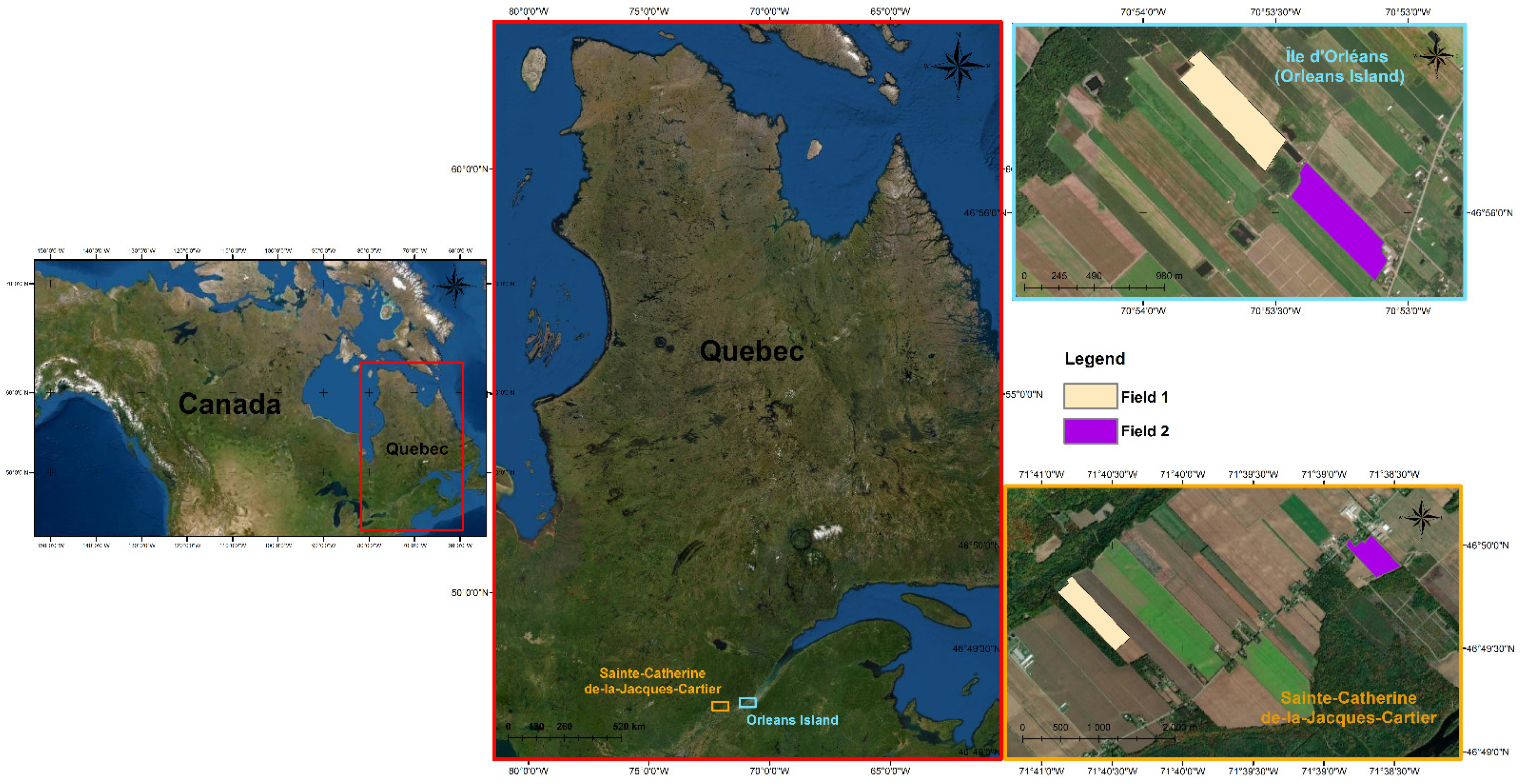
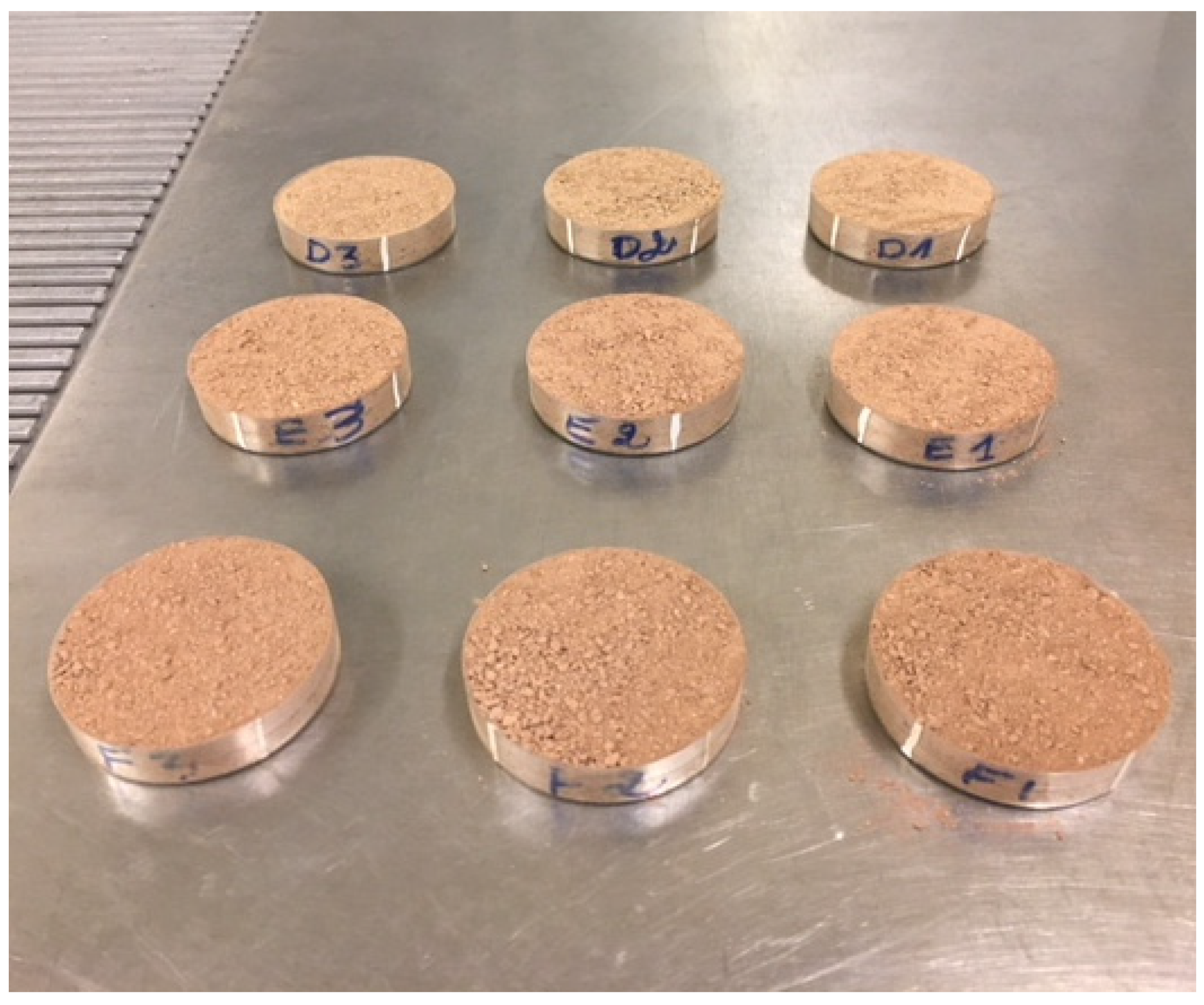
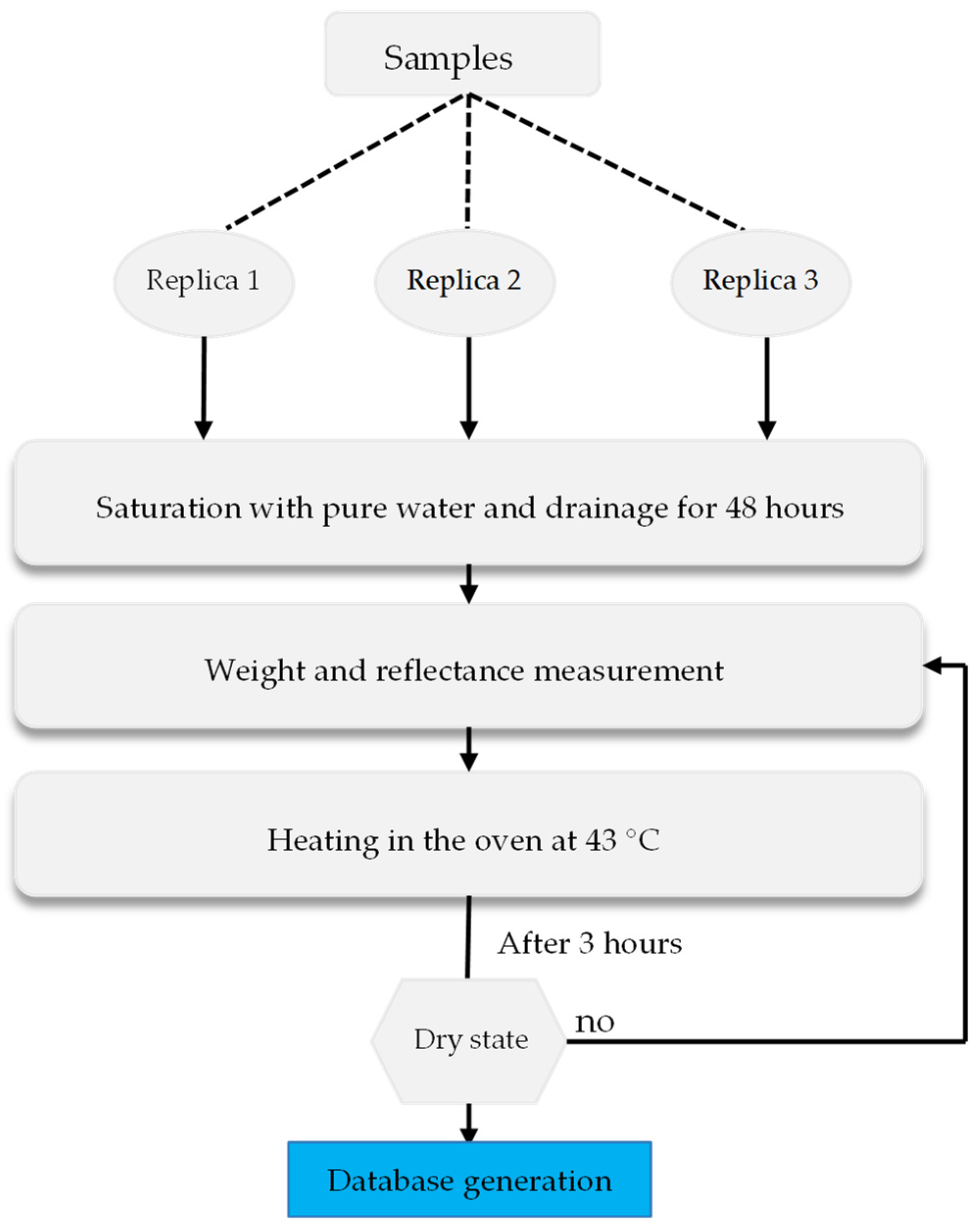


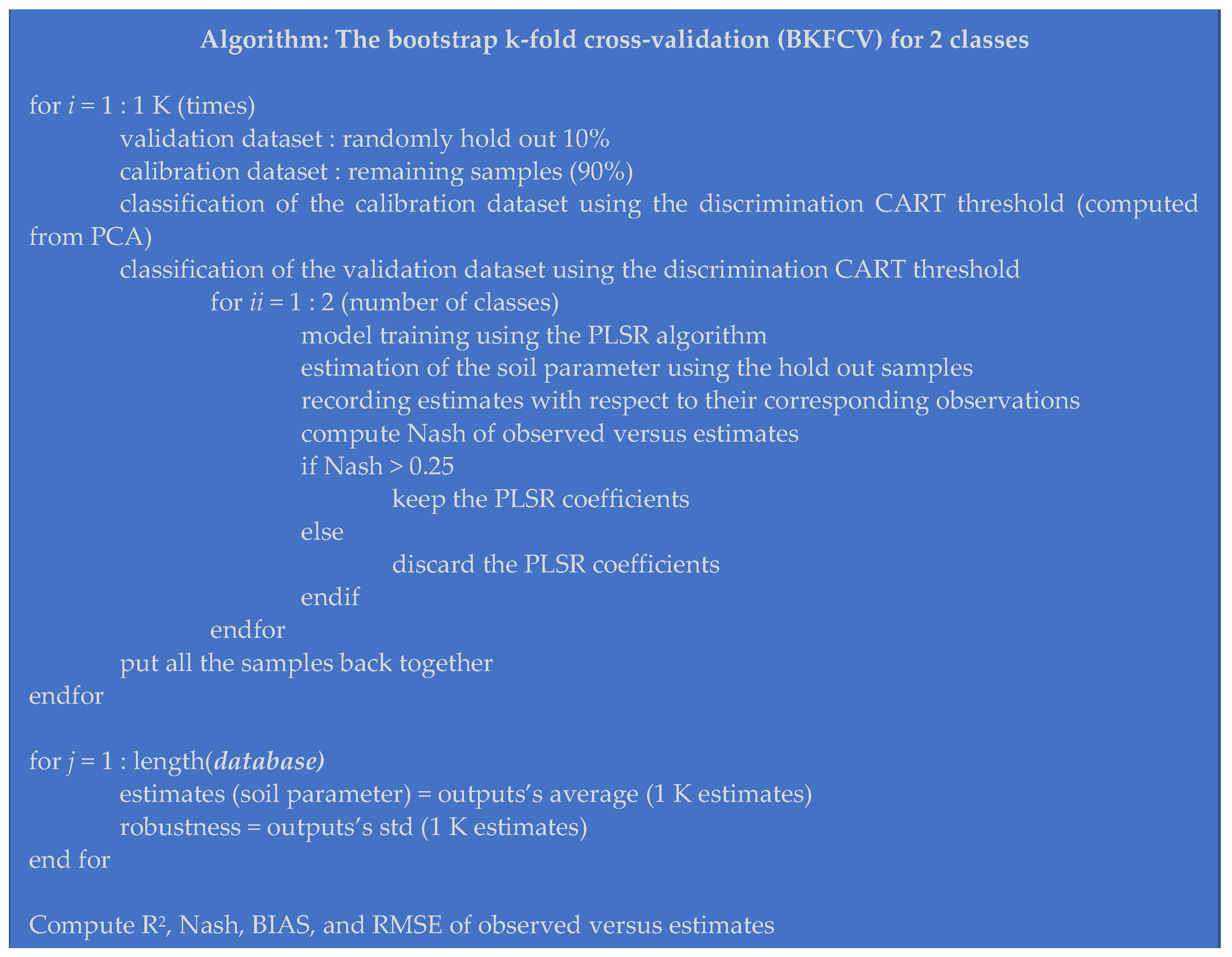
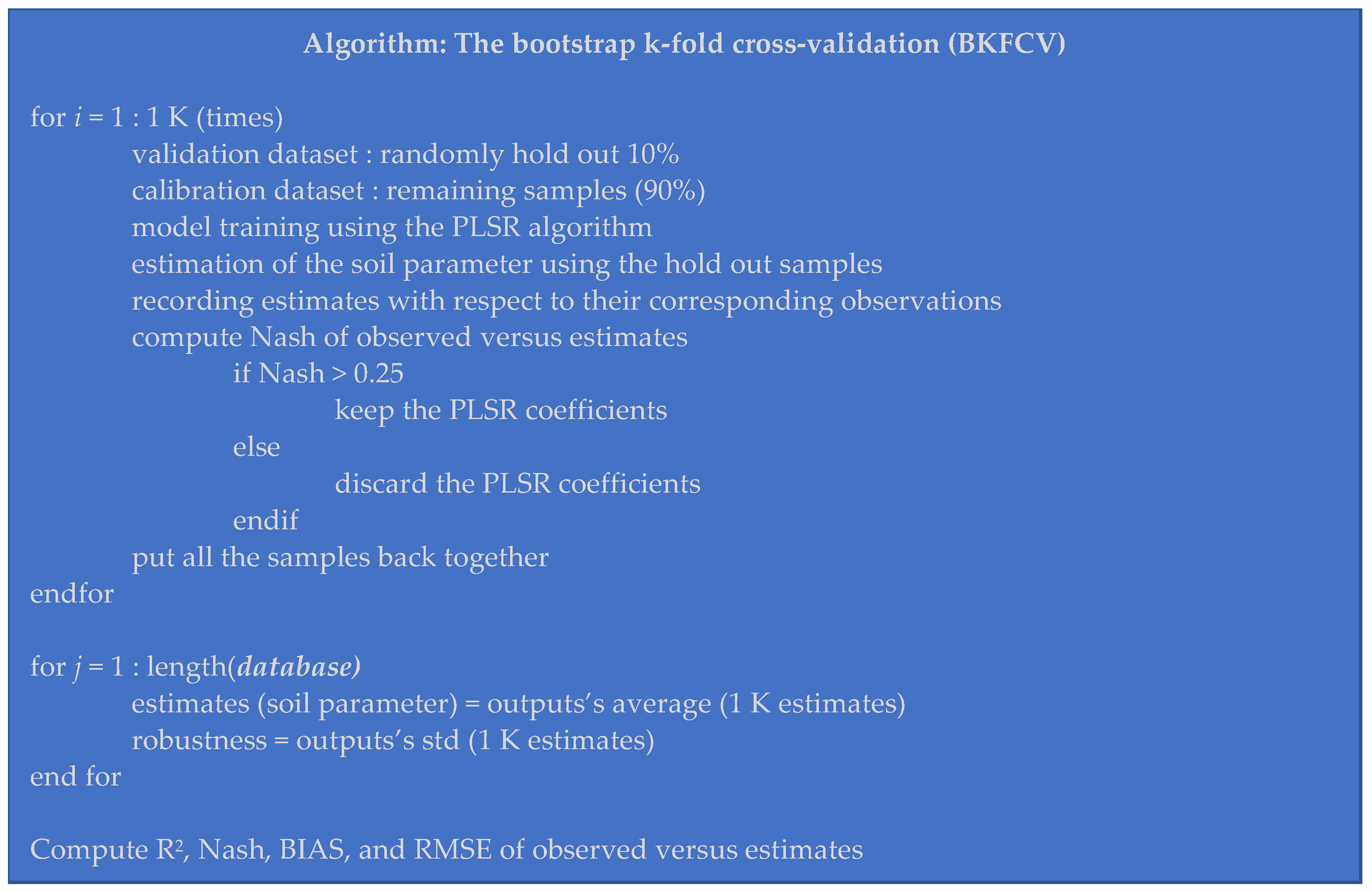
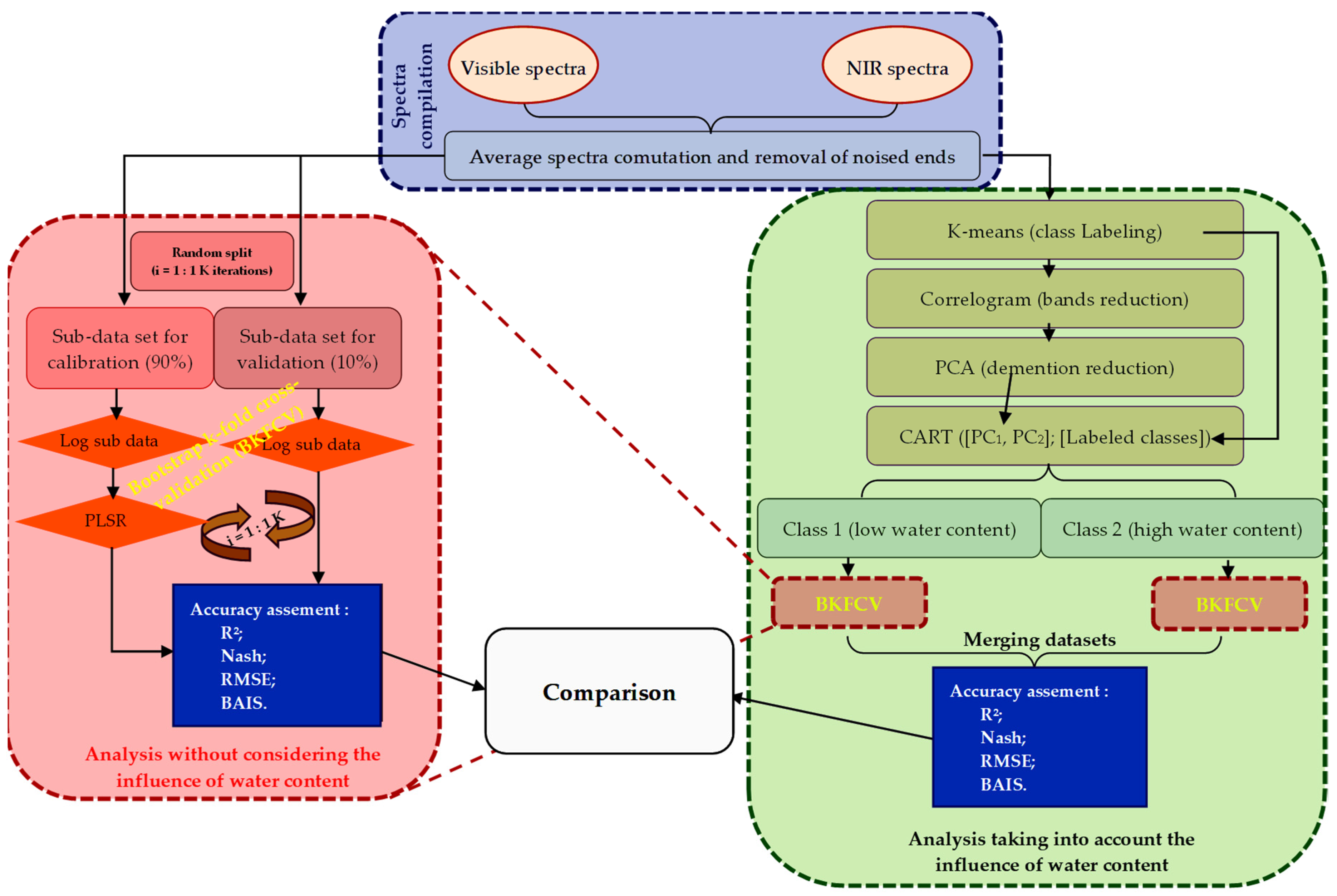
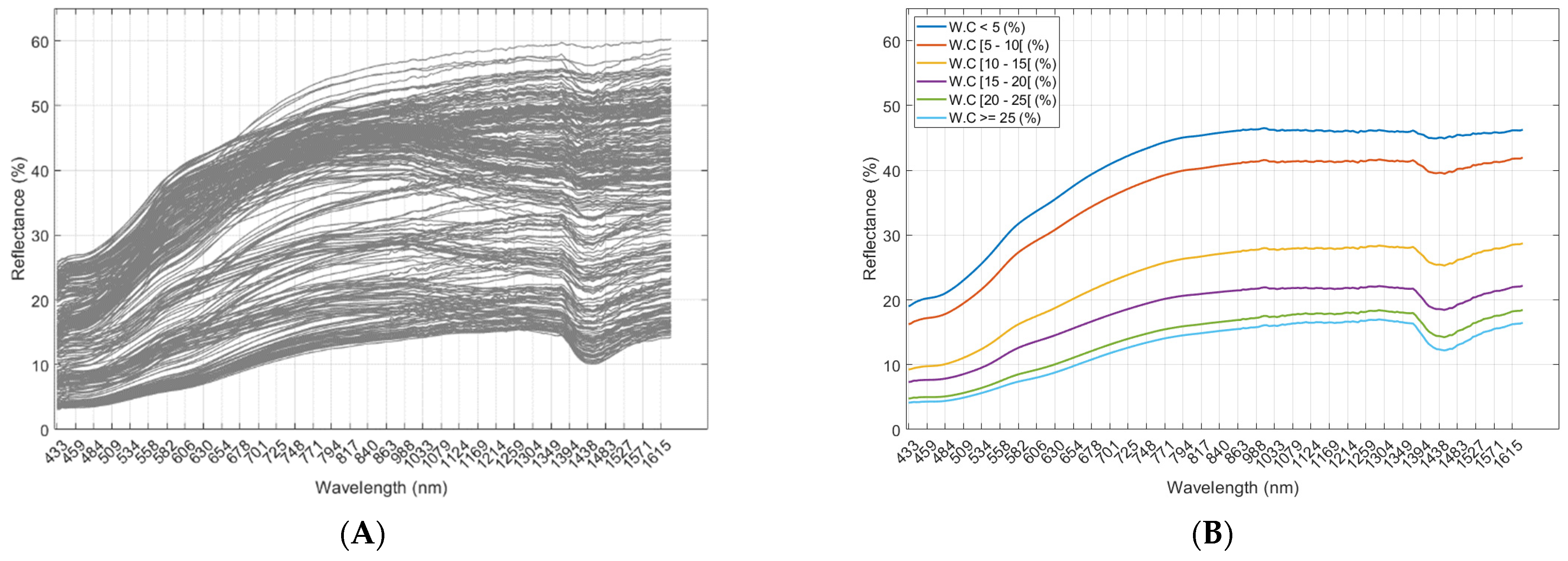
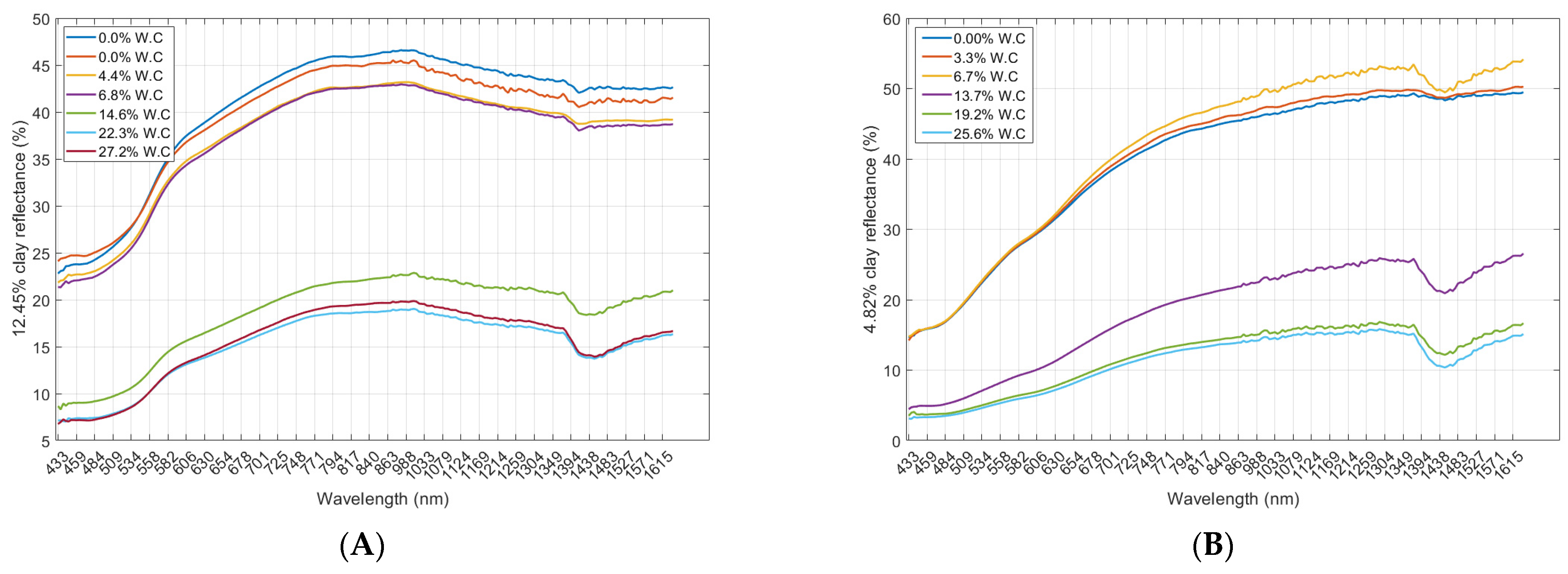
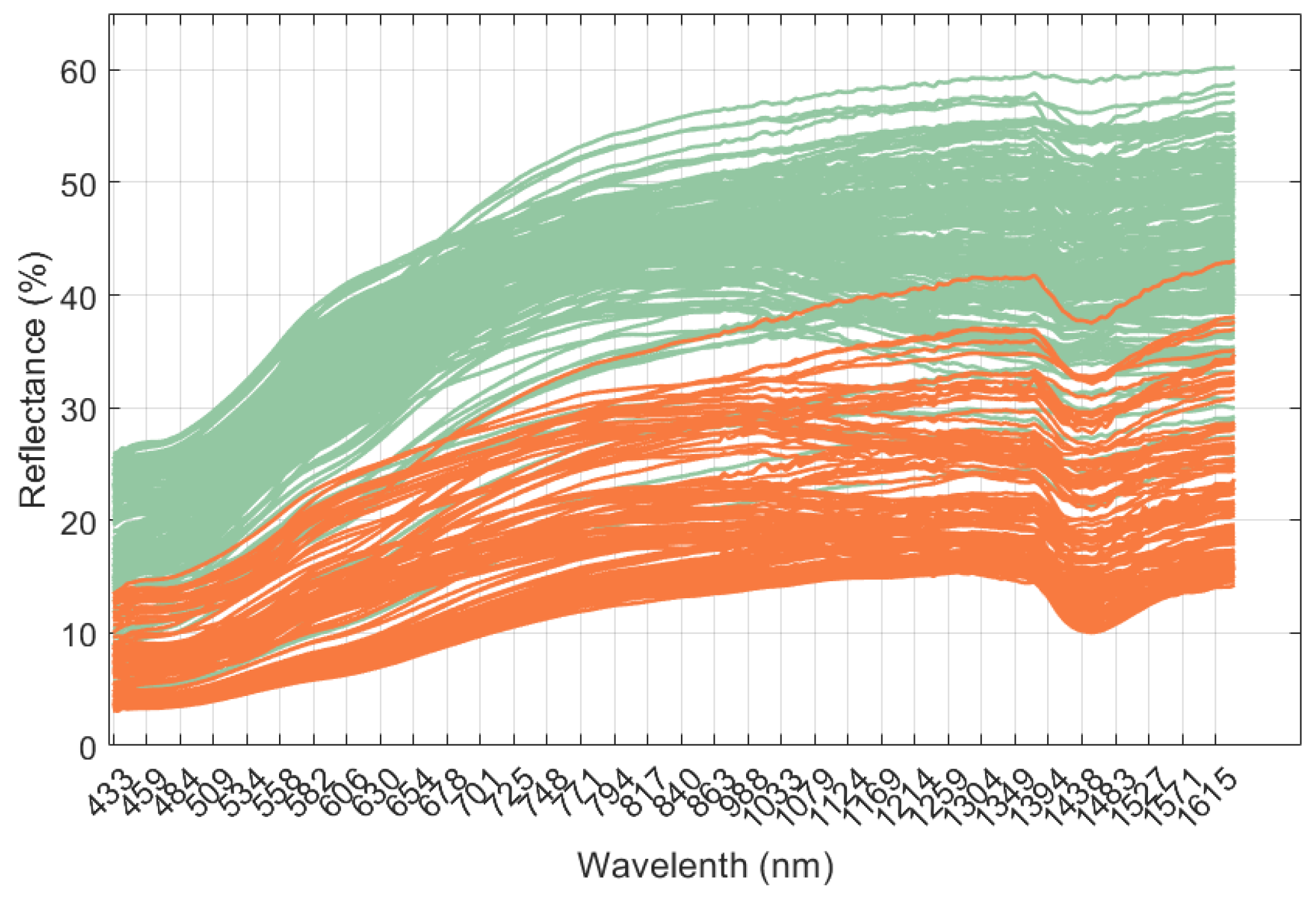
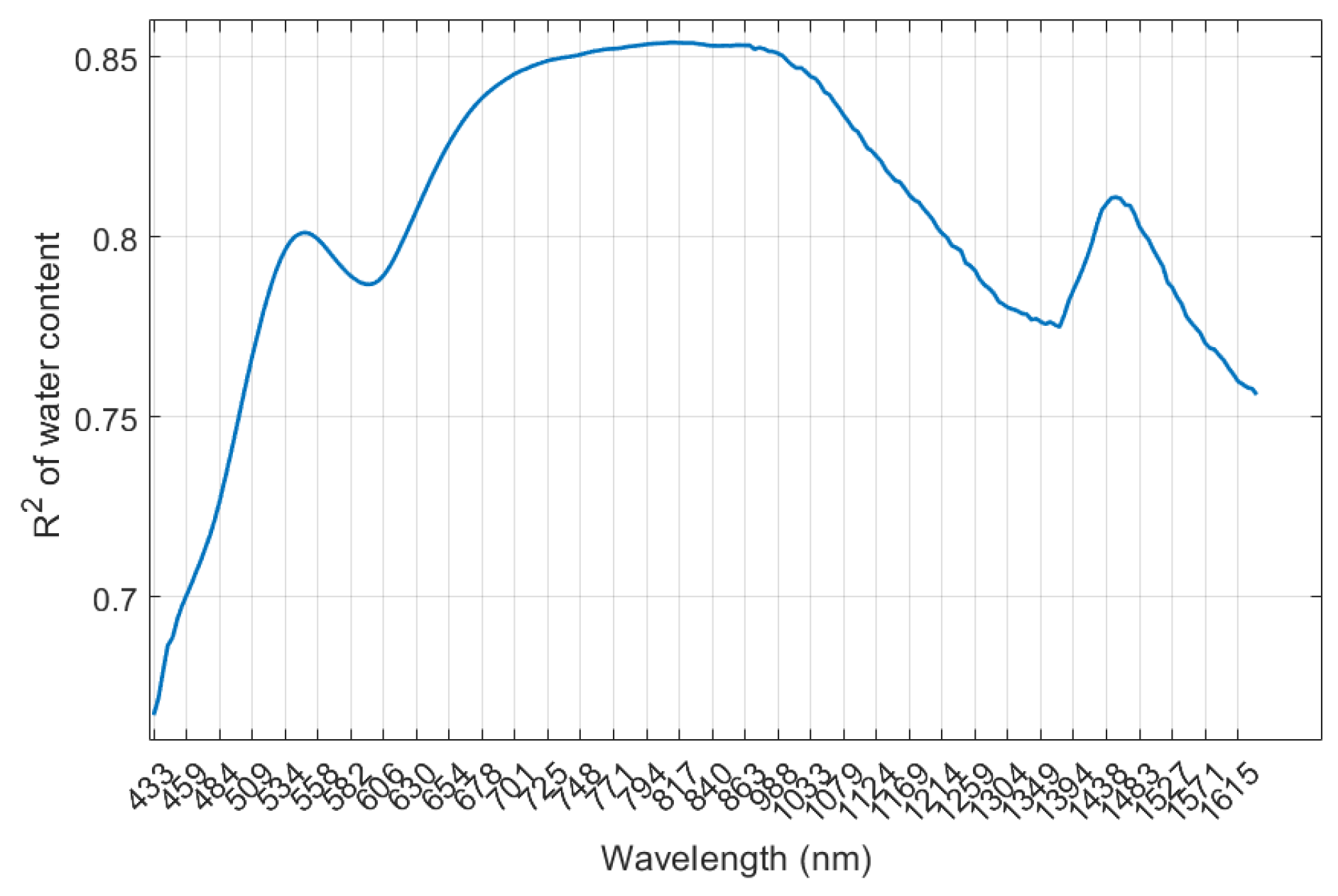
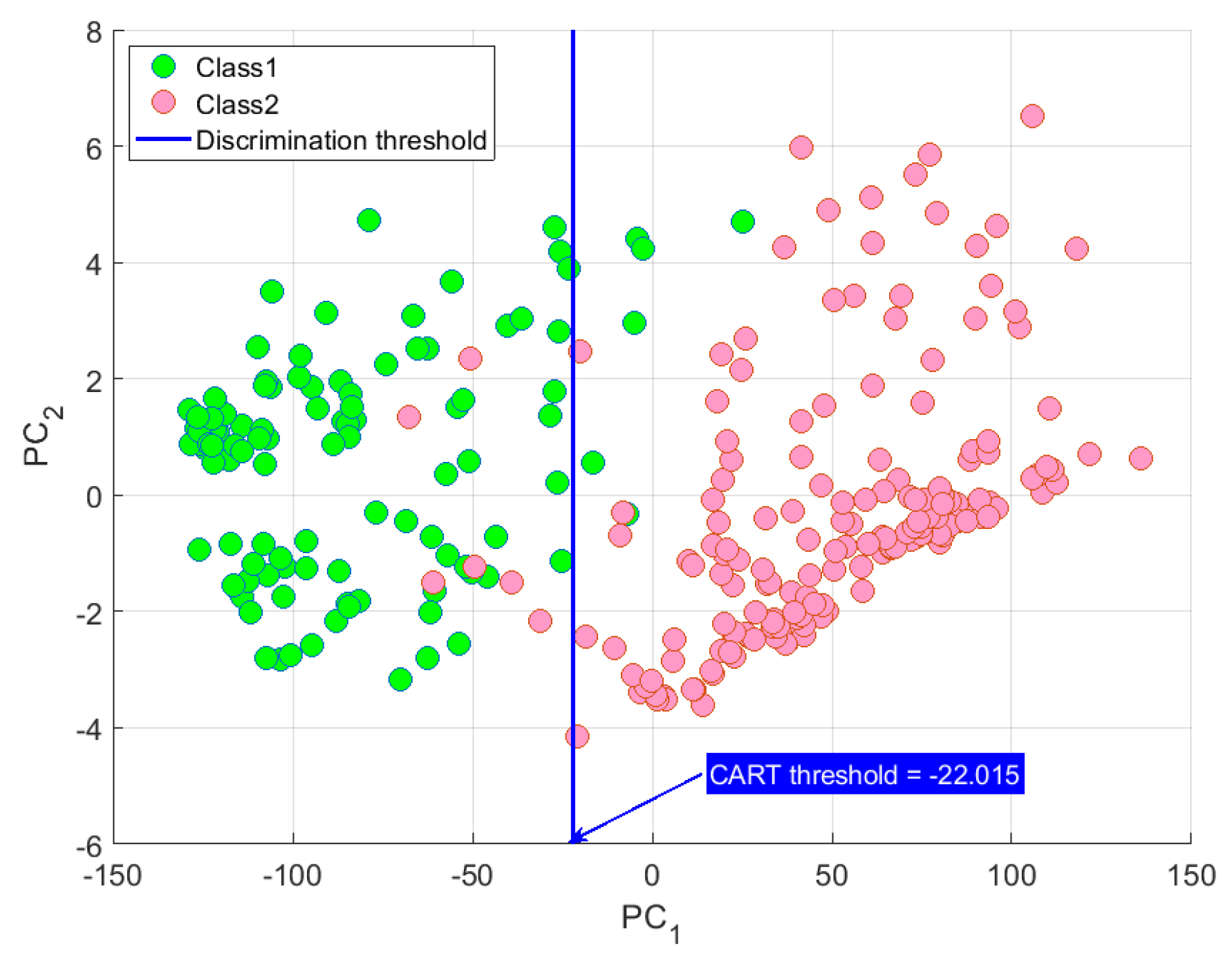

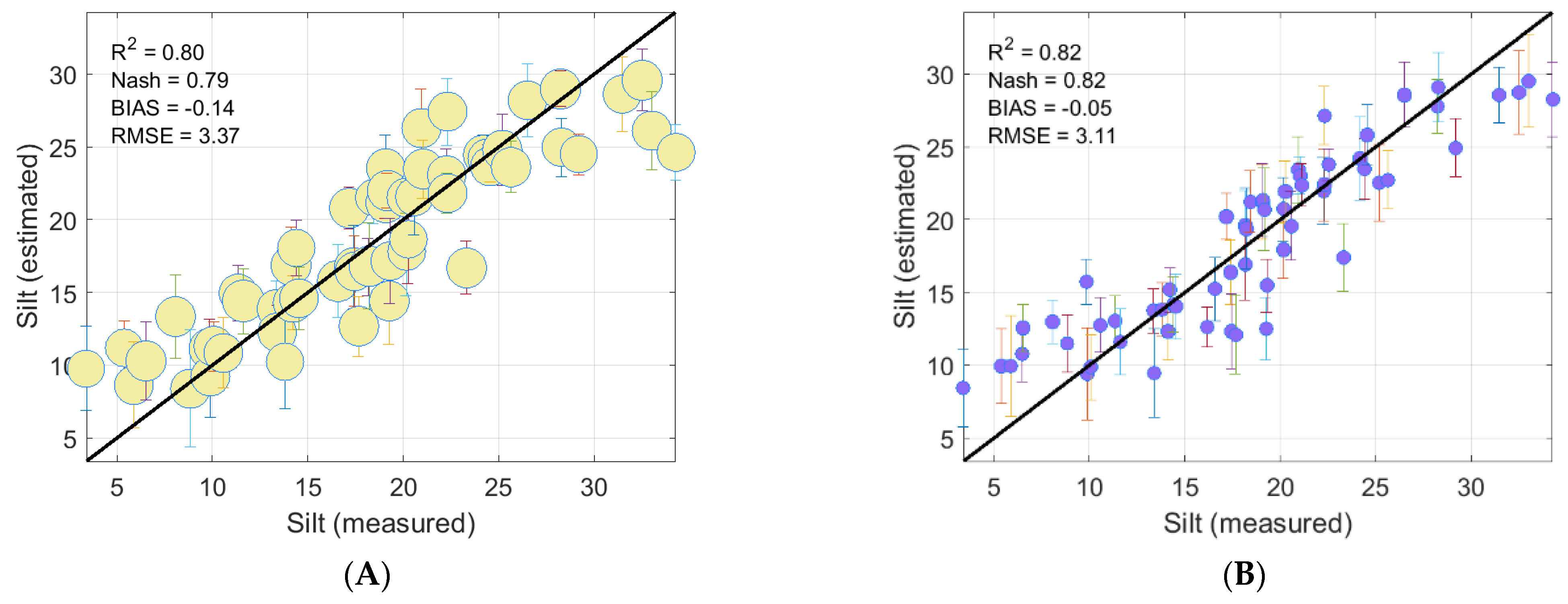
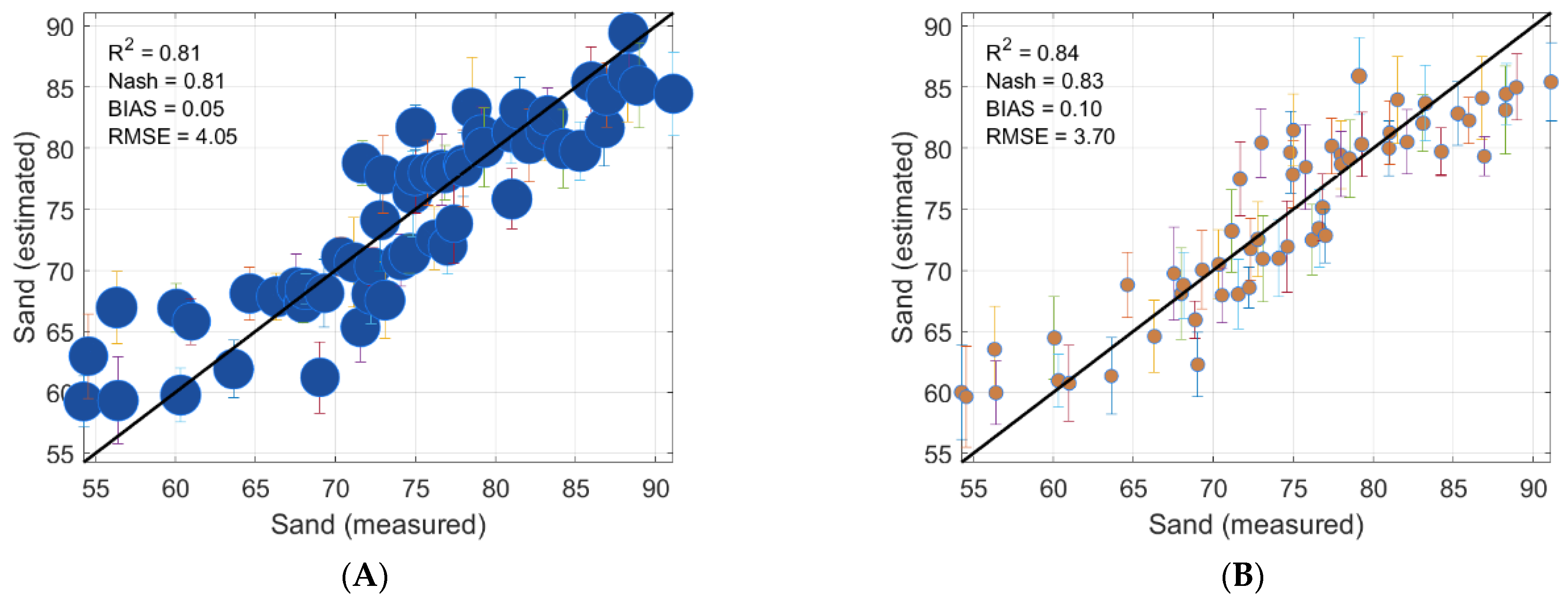
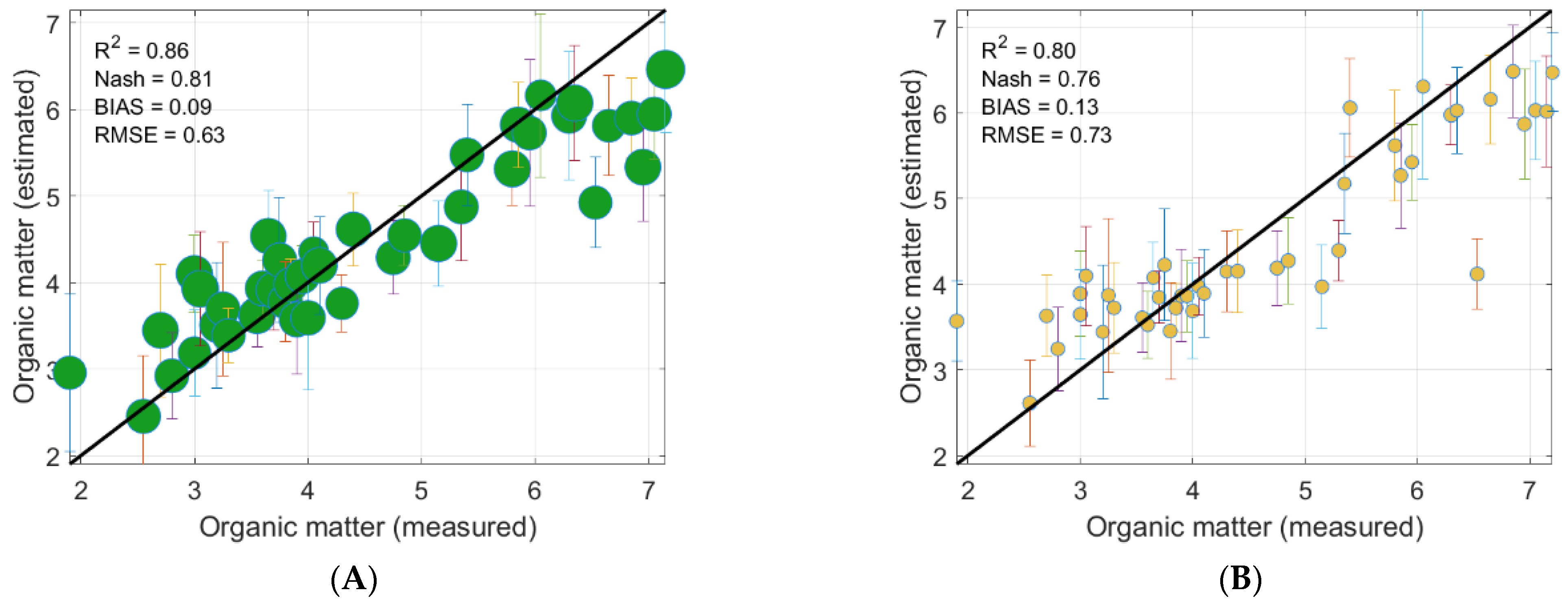

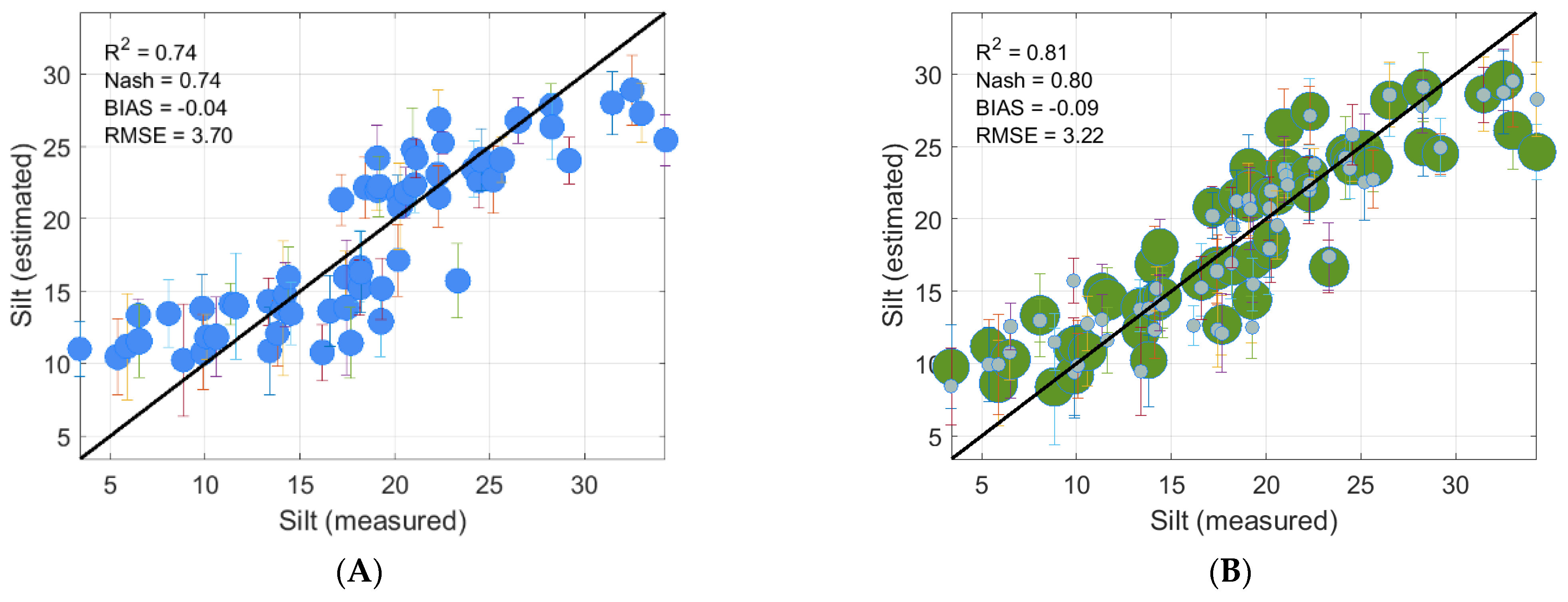
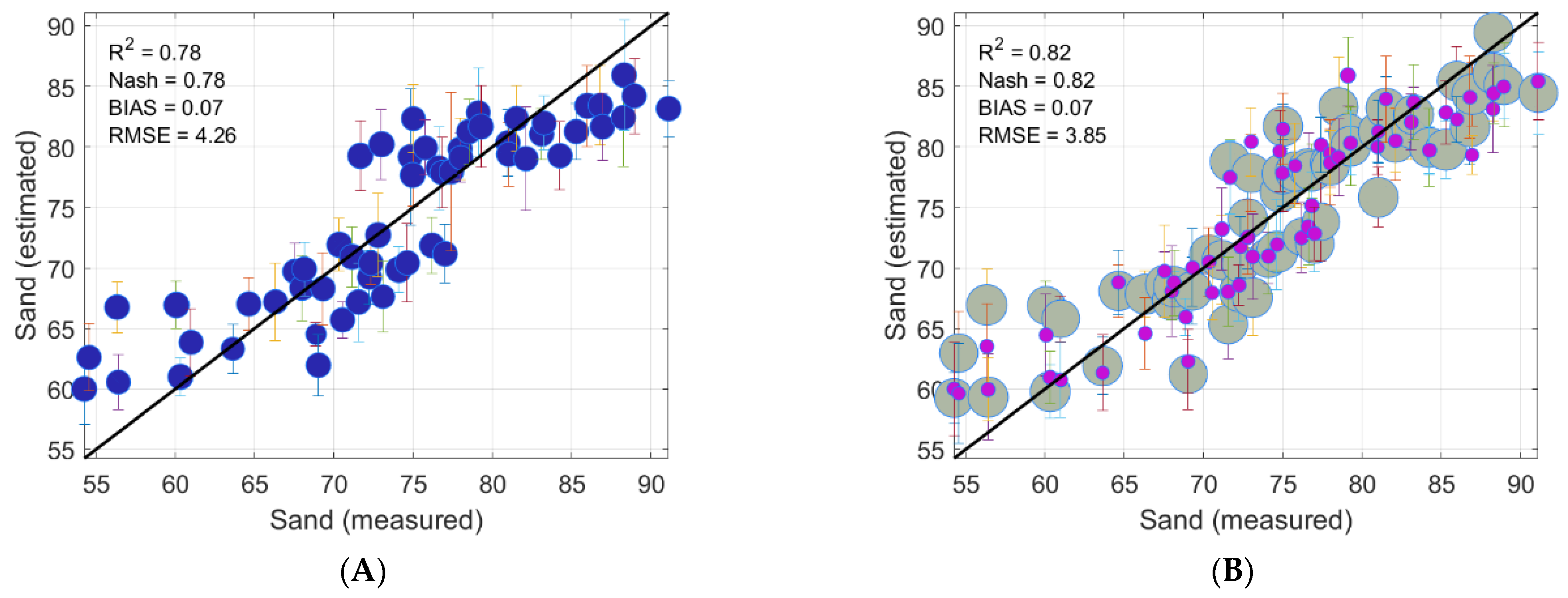
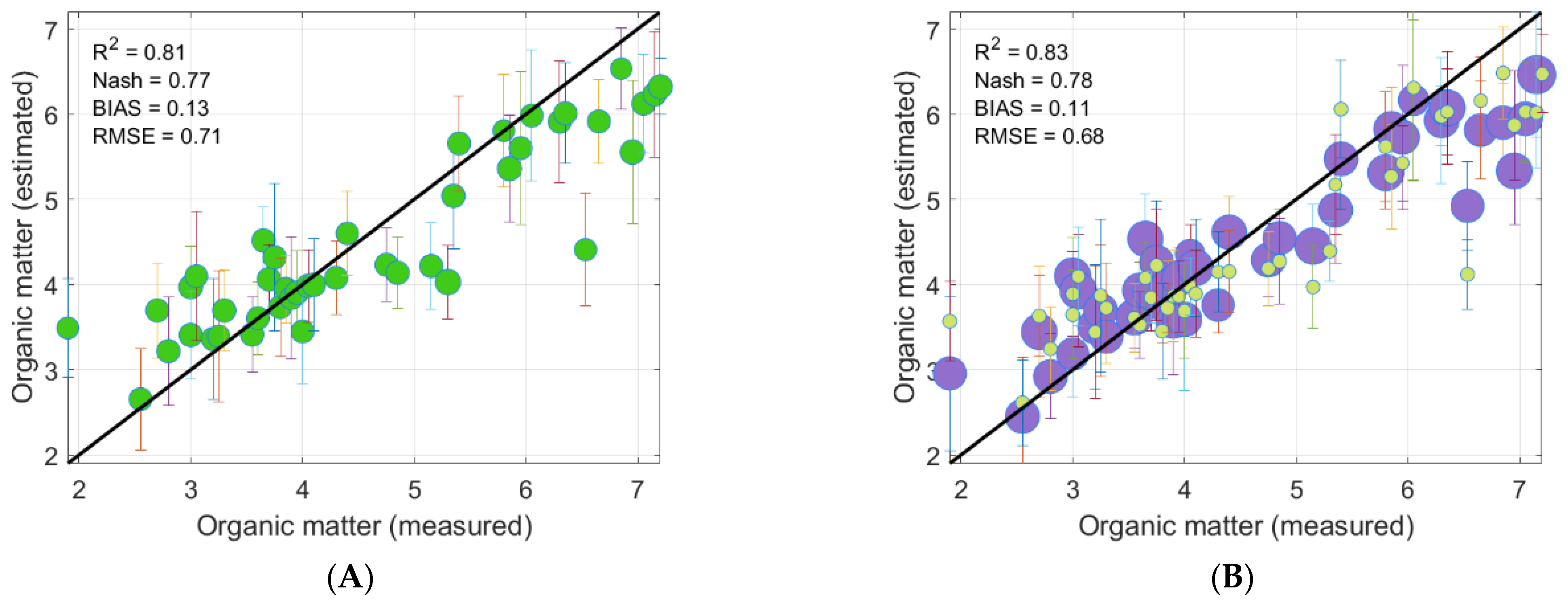
| Name of the Site | Sainte-Catherine de la Jacques-Cartier | Ile d’Orléans (Orleans Island) | ||
|---|---|---|---|---|
| Field | 1 | 2 | 1 | 2 |
| Soil Type | Sandy soil | Sandy soil | Loamy soil | Gravelly soil |
| Soil Texture | Loamy coarse sand | Loamy coarse sand | Coarse sandy loam | Coarse sandy loam |
| Soil series | Pont-Rouge | Morin | Orléans | Saint-Nicolas |
| Soil Taxonomic | Orthic Humo-Ferric Podzol | Orthic Humo-Ferric Podzol | Eluviated Dystric Brunisol | Orthic Humo-Ferric Podzol |
| Property | Minimum | Maximum | Average | Standard Deviation |
|---|---|---|---|---|
| Water content (%) | 0.00 | 31.37 | 8.75 | 8.42 |
| Clay content (%) | 2.72 | 13.23 | 7.13 | 2.36 |
| Silt content (%) | 3.40 | 34.27 | 18.54 | 7.41 |
| Sand content (%) | 54.25 | 91.10 | 74.21 | 9.07 |
| Organic matter content (%) | 1.90 | 7.20 | 4.34 | 1.35 |
| Without Considering the Influence of Water Content | Considering the Influence of Water Content | ||||||
|---|---|---|---|---|---|---|---|
| R2 | Nash | BIAS | RMSE | R2 | Nash | BIAS | RMSE |
| 0.80 | 0.80 | −0.01 | 1.07 | 0.83 | 0.83 | −0.03 | 1.00 |
| 0.74 | 0.74 | −0.04 | 3.70 | 0.81 | 0.80 | −0.09 | 3.22 |
| 0.78 | 0.78 | 0.07 | 4.26 | 0.82 | 0.82 | 0.07 | 3.85 |
| 0.81 | 0.77 | 0.13 | 0.71 | 0.83 | 0.78 | 0.11 | 0.68 |
Publisher’s Note: MDPI stays neutral with regard to jurisdictional claims in published maps and institutional affiliations. |
© 2022 by the authors. Licensee MDPI, Basel, Switzerland. This article is an open access article distributed under the terms and conditions of the Creative Commons Attribution (CC BY) license (https://creativecommons.org/licenses/by/4.0/).
Share and Cite
El Alem, A.; Hmaissia, A.; Chokmani, K.; Cambouris, A.N. Quantitative Study of the Effect of Water Content on Soil Texture Parameters and Organic Matter Using Proximal Visible—Near Infrared Spectroscopy. Remote Sens. 2022, 14, 3510. https://doi.org/10.3390/rs14153510
El Alem A, Hmaissia A, Chokmani K, Cambouris AN. Quantitative Study of the Effect of Water Content on Soil Texture Parameters and Organic Matter Using Proximal Visible—Near Infrared Spectroscopy. Remote Sensing. 2022; 14(15):3510. https://doi.org/10.3390/rs14153510
Chicago/Turabian StyleEl Alem, Anas, Amal Hmaissia, Karem Chokmani, and Athyna N. Cambouris. 2022. "Quantitative Study of the Effect of Water Content on Soil Texture Parameters and Organic Matter Using Proximal Visible—Near Infrared Spectroscopy" Remote Sensing 14, no. 15: 3510. https://doi.org/10.3390/rs14153510
APA StyleEl Alem, A., Hmaissia, A., Chokmani, K., & Cambouris, A. N. (2022). Quantitative Study of the Effect of Water Content on Soil Texture Parameters and Organic Matter Using Proximal Visible—Near Infrared Spectroscopy. Remote Sensing, 14(15), 3510. https://doi.org/10.3390/rs14153510






